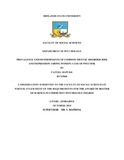Please use this identifier to cite or link to this item:
https://cris.library.msu.ac.zw//handle/11408/3705Full metadata record
| DC Field | Value | Language |
|---|---|---|
| dc.contributor.author | Mapuke, Fatima | - |
| dc.date.accessioned | 2019-09-03T07:58:56Z | - |
| dc.date.available | 2019-09-03T07:58:56Z | - |
| dc.date.issued | 2018 | - |
| dc.identifier.uri | http://hdl.handle.net/11408/3705 | - |
| dc.description.abstract | Women deal with a certain level of mental stress which puts them at risk of Common Mental Disorders (CMD), particularly depression. In Zimbabwe, mental distress goes unnoticed and undiagnosed due to the current huge mental treatment gap in the nation. This study sought to identify the prevalence of CMD risk and depression as well as their determinants among women who attended a mental health communication program in Harare Central Province named Psycook. A total population sample of 140 women aged between 18 and 63 years, were investigated via a survey based, non-experimental descriptive research design. The research instrument comprising of SSQ-14 to determine CMD risk, PHQ-9 to screen for depression, and SPLQ-14 to assess for determinants was distributed. A total of (n=138) questionnaires were returned and analyzed using SPSS and STATA to provide descriptive and inferential statistics. A CMD risk prevalence of 39.9% and a depression prevalence of 29% were recorded. Age (P=0.02), relationship problems (P=0.00); interpersonal deficits (P=0.01); and sexual problems (P=0.01) were found to be strong influencers of CMD and/or depression. Money problems was the most mentioned problem; however, its ubiquitous presence did not have any significant impact on the women’s mental wellbeing. These findings, being community based, carry potentially previously unrecognized CMD and depression prevalence indicating underdiagnosis where the high rates are likely to be driven by two main factors. Firstly, compared to developed and western societies, women in Zimbabwe are more likely to attribute mental illness to spiritual and personally controllable factors creating a stigma filled environment for sufferers. Secondly, the high treatment gap caused by the scarcity of mental health care providers leaves many with little or no knowledge of mental illnesses hence instead of seeking psychological help most present with somatic symptoms increasing the likelihood of CMD and depression going undetected. Future interventions to address CMD risk and depression will do well by focusing on other communities especially rural communities to address underdiagnosis as well as to investigate relational issues among women. | en_US |
| dc.language.iso | en | en_US |
| dc.publisher | Midlands State University | en_US |
| dc.subject | Women | en_US |
| dc.subject | Mental stress | en_US |
| dc.subject | Mental disorders | en_US |
| dc.title | Prevalence and determinants of common mental disorder risk and depression among women: case of Psycook | en_US |
| item.fulltext | With Fulltext | - |
| item.grantfulltext | open | - |
| item.languageiso639-1 | en | - |
| Appears in Collections: | Master Of Science In Community Psychology | |
Files in This Item:
| File | Description | Size | Format | |
|---|---|---|---|---|
| Fatima_dissertation executive binding_final.pdf | Full Text | 2.74 MB | Adobe PDF |  View/Open |
Page view(s)
262
checked on Nov 23, 2025
Download(s)
168
checked on Nov 23, 2025
Google ScholarTM
Check
Items in MSUIR are protected by copyright, with all rights reserved, unless otherwise indicated.



